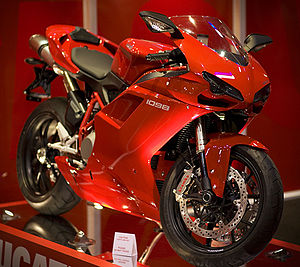Ducati 1098
 |
|
| Manufacturer | Ducati |
|---|---|
| Also called | "Ten-nine-eight" |
| Production | 2007–2008 (1098R: 2007–2009) |
| Predecessor | 999 |
| Successor | 1198 |
| Class | Sport bike |
| Engine | 1099–1198 cc 90° V-twin cylinder, 4 valve per cylinder Desmodromic, liquid cooled |
| Top speed | 173.3 mph (278.9 km/h) |
| Power | 160–180 hp |
| Torque | 90–99 ft·lbf |
| Related | Ducati 848 |
The Ducati 1098 is a sport bike made by Ducati from 2007 to 2009, in three versions, the 1098, 1098S, and 1098R. The 1098 was succeeded by the 1198 in 2009, though the 1098R remained in production that year.
The 1098 shares more design elements with the older 998 than with its predecessor the 999, such as horizontally placed headlights and a non-integrated exhaust system. Another carryover from its 916/998 heritage is the single-sided swingarm. This return to a more traditional Ducati design has been welcomed by many Ducati fans who criticized the design of the 999. The Ducati 1098/1098 S/1098 R were available in black, red, yellow and a special edition 1098s in the Italian national flag colours of red, white and green called Tricolore. The 1098 was designed by Ducati designer, Giandrea Fabbro.
The 1098/1098 S makes a manufacturer claimed 160 hp (119 kW),138 hp (103 kW) rear wheel, 90.4 lb·ft (123 N·m) torque, 77.9 lb·ft (106 N·m) rear wheel, and weighs 173 kg (381 lb). The 0-60 mph time is less than 3.0 seconds and 1/4 mile at 10.015 seconds at 143.94 mph (231.65 km/h) and top speed of 173.3 mph (279 km/h). The 1098 R, with its larger displacement 1198 cc engine, makes a manufacturer claimed 180 hp (134 kW), 99.1 lb·ft (134 N·m) torque. All these figures give the 1098 the highest torque-to-weight ratio of any production sport bike ever made.
With the release of the 1098, Ducati created a stir not only with road riders, but also in the racing world, specifically the Superbike World Championship. In an attempt to level the playing field, WSBK regulations provide for concessions to motorcycles depending on the number of cylinders in their engine design. The fewer the cylinders, the more concessions, and with its two cylinder V-twin design Ducati was able to capitalize on many of these concessions.
Ducati argued that the current engine was at the end of its design life (which surrendered as much as 20 hp to the competition in 2007, its last year in WSBK) and that it would be too expensive to keep the 999 competitive. The 2007 WSBK rules limited V-twin engines to 1000 cc, so Ducati effectively did not have a guarantee that the 1098 was eligible for entry in the premier class. Before releasing the 1098, Ducati lobbied the to update the WSBK rules to accommodate its new bike, threatening to withdraw from WSBK competition if the rules weren't changed. Other manufacturers were not happy about racing a bike with a larger engine, especially when that bike belonged to Ducati, which has historically dominated WSBK competition, and Suzuki even threatened to withdraw if the rules were changed. Ducati prevailed when, in June 2007, the FIM announced that the engine capacity limit would increase to 1200 cc for 2008. However, this increase in displacement was not afforded without concessions on the part of Ducati. With the new 1200 cc maximum displacement for two-cylinders granted, the extra engine modifications allowed two-cylinder machines were surrendered. Engine modification rules for two-cylinder and four-cylinder machines are now parallel. Rules for three-cylinder machines remain as before.
...
Wikipedia
